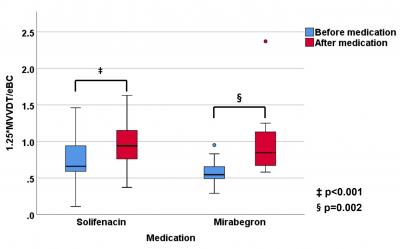|
|
|
소아 일차성 과민성 방광 환자에서 솔리페나신 대비 미라베그론의 유용성과 안정성 비교: 예비연구 |
| 울산대학교병원 비뇨기과학교실 |
| 김성철, 박명찬, 채종석, 윤지형, 권택민, 박세준, 문경현, 박성천 |
Purpose: The aims of this study were to compare the efficacy and the tolerability of mirabegron to solifenacin in pediatric patients with idiopathic overactive bladder (OAB), and to identify factors affecting the improvement of overactive bladder symptoms after medication.
Materials and methods: We reviewed 103 patients retrospectively, aged between 5 and 15 years, who visited to our hospital with a complaint of OAB symptoms from July 2017 to March 2019. All participants had taken solifenacin or mirabegron. Those who had secondary OAB or did not write frequency volume chart either before or after medication were excluded from this study. The age-adjusted bladder capacity ratio was used to evaluate bladder capacity. Efficacy and tolerability were assessed by reports from patients and parents, and ≥90% reduction was regarded as responding to medication.
Results: After 58 patients were excluded, 45 (29 with solifenacin, 16 with mirabegron) were included in the primary analysis. The age-adjusted bladder capacity ratio increased from 0.71 to 0.96 (p<0.001) and from 0.57 to 0.97 (p=0.002) after solifenacin and mirabegron use, respectively. Decreased bladder capacity before medication was a factor associated with symptom improvement (Odds ratio: 7.41, p=0.044). There was no difference in efficacy between the two drugs. Drug-induced side effects were reported in only 3 (10.3%) of the solifenacin patients.
Conclusion: Mirabegron showed comparable efficacy to solifenacin in pediatric patients with idiopathic OAB. Additionally, there were few side effects, so mirabegron can be a safe alternative drug for idiopathic pediatric OAB patients.
|
 |
|
keywords : overactive bladder; child; urinary bladder, enuresis |
|

